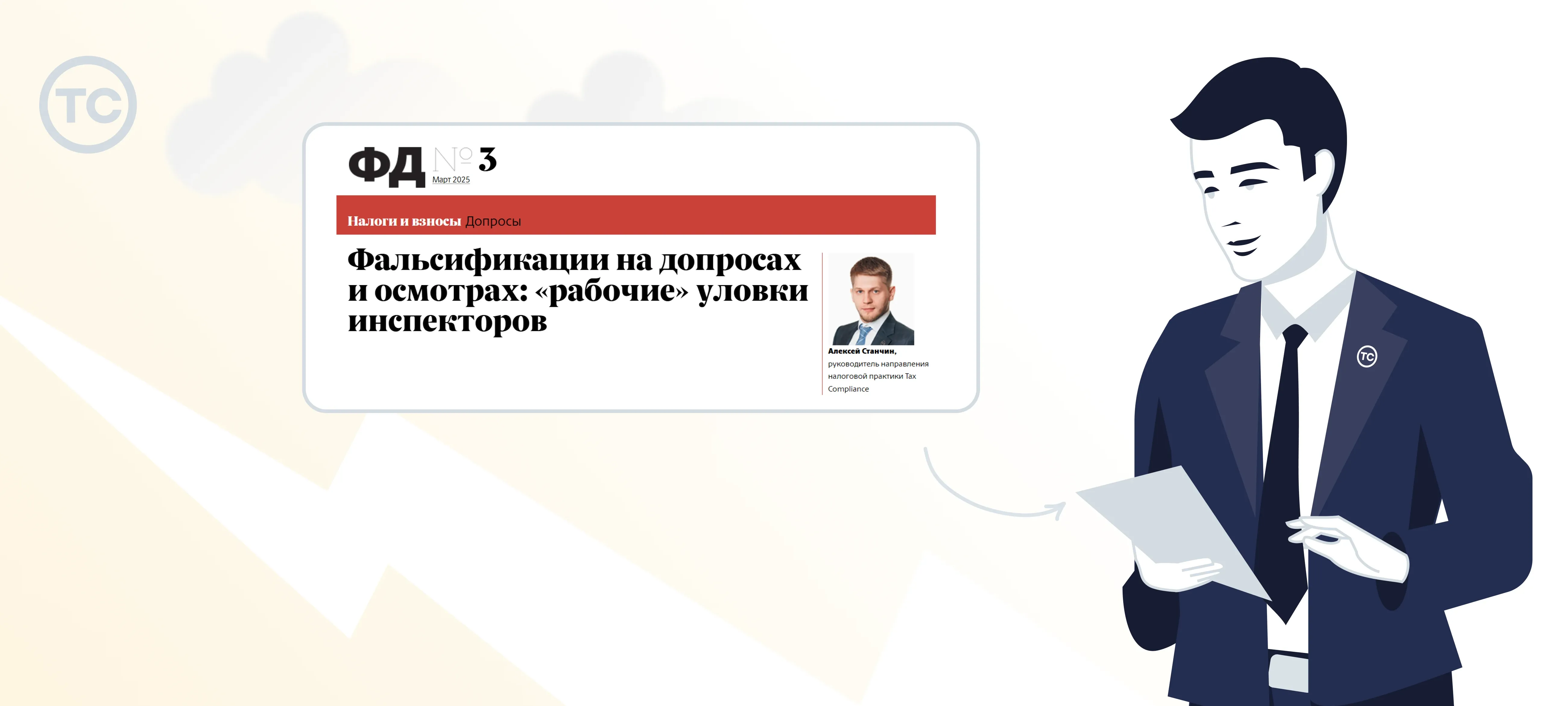CFOs are key figures in the management of a company's financial flows. In their hands are huge amounts of data, which are necessary for decision-making and budgeting. An important component of this data is the tax block, which has a significant impact on the reporting indicators.
In the course of control measures, situations may arise when tax inspectors use various tricks and abuses. In this case, the emergence of new evidence that distorts the actual circumstances may affect not only the amount of claims of the tax authority, but also the reputation of the CFO, who previously confirmed the reliability of their financial documents.
In his article in the Financial Director magazine, Alexey Stanchin, head of the Tax Compliance practice area, explained how to recognize such violations, at what stages of an audit one should be particularly attentive and what tools should be used to minimize the risks of falsification.
Do we face falsifications in every dispute?
First of all, it should be noted that in our practice there are fewer cases of outright falsification and abuse by tax officials. This may be due to preventive measures within the tax service, as well as the use of tools that have already shown their effectiveness in our practice.
Also the fact that the tax authorities take into account not only the actions of specific officials of the taxpayer, but also the results of previous audits of representatives of companies may affect the reduction of such cases.
Why do inspections and interrogations most often involve risks of falsification?
Falsification usually involves the deliberate distortion or alteration of facts in order to benefit one of the parties to resolve a dispute.
Cases of falsification are most common during examinations and interrogations. This can be explained by the fact that in tax disputes the main evidence is the protocols of interrogations and inspections. That is, written documents drawn up by an official that describe what happened.
Unlike criminal proceedings, where the court directly perceives the testimony of the witness, in the tax court it is the document drawn up by the person who perceived the fact itself that is evaluated.
Interrogations
Taxpayers who have faced pre-audits and tax audits already know that interrogations are one of the most problematic and tangible control measures. Below we will analyze the examples that we have encountered in our work, both outside of audits, and during field and in-house audits.
They do not hand over all interrogation protocols
Some tricks of inspectors are quite difficult to circumvent, except with the help of a structured organization of work with labor personnel. For example, quite common is the interpretation of tax officers that they are not obliged to attach to the audit materials all the protocols of interrogation, but can limit themselves exclusively to those that support the arguments of the tax authority.
In court cases we can find evidence of such a problem. For example, in the Decision of the Moscow Arbitration Court of 27.09.2023 in case N A40-129169/23-140-2240 the court stated:
«... to the act of tax audit in violation of the provisions of Articles 100, 101 of the Tax Code of the Russian Federation are not attached materials (protocols of interviews with witnesses, ) that were obtained in the course of the tax audit, but refute the version of the tax authority on the lack of supply of goods from the counterparty ...».
This should also include situations where an inspectorate deliberately fails to question the most knowledgeable witnesses (employees of a taxpayer) and justifies its position by the testimony of persons who, due to their official duties/specifics of work, could not possess the information requested by the tax authority.
Thus, for example, in the Decision of the Tenth Arbitration Appeal Court of 06.04.2022 N 10AP-27084/2021 in the case N A41-35634/2021 the court found that the representatives of the inspection refers to the interrogations of those persons who do not know and could not know about the interaction of the taxpayer with the disputed counterparties:
«The witnesses on whose testimony the Inspectorate bases its decision are not employees of the Taxpayer who are directly involved in interaction with the disputed counterparties and, therefore, do not possess the necessary information».
The same questions are asked
Another common trick: the inspector during questioning asks a question, and after some time asks a similar question. The actions of the inspector are understandable and logical: he is trying to show that the witness gives confusing testimony and his testimony, if it confirms the facts of the taxpayer, can not be recognized as reliable.
Meanwhile, there is another view: witnesses are not always persons who are knowledgeable and have basic knowledge of taxes. Very often such contradictions are solely a misunderstanding of the essence of the issue and a good faith misconception that the issues are different.
Here is an example:
Question No. 1. Did you have any interaction with your colleagues from Germany?
The witness answered, «No, I did not»
Question No. 2. Company N (Germany) provided in the audited period services on... ?
Witness: began to list the services that were provided by the German company.
The countermeasure tool is quite simple in such a situation. It is necessary to point out the contradiction at the time of writing the protocol and to inform that the witness may have misunderstood the question. In most cases, this is sufficient to resolve the contradiction.
Questions unrelated to the subject of the audit are asked
For example, such abuses arise in cases when the tax authority in the course of a desk audit for value added tax goes beyond the subject of the audit and begins to ask questions related to income tax.
In particular, these may include inquiries about a company's financial losses and related transactions. The tactics used by the tax authority may serve several purposes: first, it may serve as an attempt to incriminate the company's losses, and second, the questions asked may be used to gather information for future audits.
Countermeasure tool: timely notice the questions that do not relate to the subject of the audit and exclude them from the protocol.
Factors that increase the effect
In practice, there are situations when the tax authority abuses its powers in the very conduct of the interrogation in order to put pressure on the witness.
Interrogation at the place of inspection or seizure
There are cases when inspectors try to combine several control measures. Usually, during a seizure, officers are served with summonses for interrogation. Some inspectors go further and try to interrogate employees.
The purpose of such actions is clear: inspectors try to use the tension of the situation during questioning, as the witness in such conditions may be scared, tired of constant «persecution» and pressure from the tax authority. Thereby reducing resistance and the ability to assert rights.
Interrogation at home
The situation is aimed at the same result, but the officers' actions are aimed at trying to catch the witness in an environment where his or her work issues have been left in the office. In practice, this is the case when witnesses are most often ready to sign an interrogation form filled out by the inspector without looking at it, as long as they are allowed to go home.
Resistance tool: it is quite difficult to resist the actions. It helps to conduct training on basic witness rights before the inspection as part of control measures for the company's personnel.
During the period of seizure can relieve negative pressure can be a lawyer at the control event.
Inspections
Now let's look at a number of examples from our practice related to inspections.
Formal inspection
More often there are situations when inspectors inspect the wrong premises. Especially when the company's territory is vast or there may be several premises at the same address. In the protocol, inspectors issue facts that in no way relate to the dispute.
But the most frequent case of misrepresentation of facts is the indication by the inspector in the inspection protocol on the absence of the organization at the specified address. On verification, it turns out that the inspectors asked security guards or random passers-by about the organization and did not even inspect the premises.
Tools of counteraction: attachment of photographs, videotaping, motions at the hearing for re-inspection, securing evidence from a notary.
Reference to the testimony of false or anonymous persons
In our practice there was a situation when in the inspection act the inspectors referred to the testimony of «a person who refused to present himself to the tax authority». The witness said that the counterparty did not conduct real business. In the objections, this argument of the inspectorate was challenged because it was based on anonymous testimony.
Countermeasures: request for evidence, demands for repeated participation of the persons in other events.
Improper use of information about facts
There are cases when the actions of the inspectorate cannot be directly called falsification: everything is procedurally correct and the formal component cannot be criticized. However, the use of an inspection report to confirm facts that may or may not have occurred in the past is recognized by the courts as unlawful and improper evidence.
For example, in the ruling of the Arbitration Court of the Volga District of 17.07.2023 N F06-5285/2023 in the case N A55-30421/2022, the courts note the following:
«... the indication of the tax authority, with reference to the Protocol of inspection of the territory of in June 2019, after the implementation of transactions with , cannot serve as proper evidence of the lack of reality of transactions carried out in the IV quarter of 2018 and in the I quarter of 2019».
Other courts come to similar conclusions, for example: the ruling of FAS North-Western District from 21.01.2013 in the case N A56-21895/2012, the ruling of the Arbitration Court of the North Caucasus District from 10.02.2022 N F08-14443/2021 in the case N A53-20525/2020.
It should also be borne in mind that situations where the tax authority is deluded in good faith about the actual circumstances are not excluded. Such situations occur when the auditor, due to his lack of specialized knowledge of the specifics of any technologically complex production can not correctly assess and record the actual circumstances.
For example, in our practice there was a case when the tax authority recorded the fact that there was no place of acceptance of goods. After the inspection it turned out that the navigation system in this area is quite complicated, as the place of acceptance was located in an «industrial zone». Since there were no employees of the taxpayer, and other persons could not correctly explain, the tax authority reflected information that did not correspond to reality.
Countermeasures: admission of other evidence, video recording, presentation of explanations and clarifications.
For more details on the risks of falsification during interrogations and inspections, as well as methods of combating them, see Alexey Stanchin's article published in the Financial Director magazine.
Popular
- 12.05.2025
- 06.05.2025
- 30.04.2025
- 24.04.2025
- 23.04.2025


